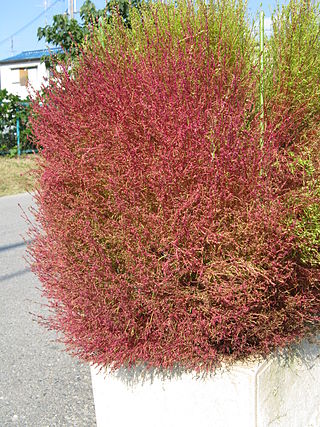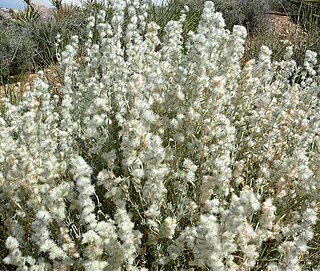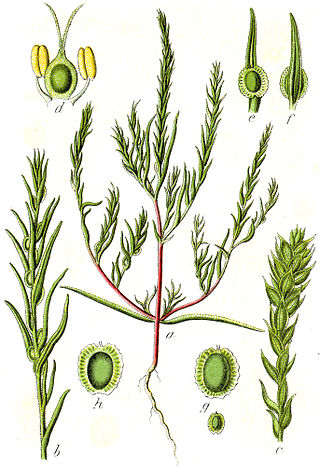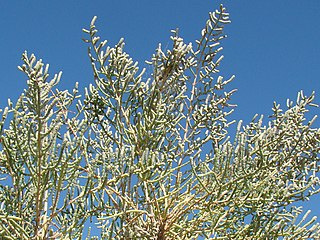
Amaranthaceae is a family of flowering plants commonly known as the amaranth family, in reference to its type genus Amaranthus. It includes the former goosefoot family Chenopodiaceae and contains about 165 genera and 2,040 species, making it the most species-rich lineage within its parent order, Caryophyllales.

Salicornia is a genus of succulent, halophytic flowering plants in the family Amaranthaceae that grow in salt marshes, on beaches, and among mangroves. Salicornia species are native to North America, Europe, Central Asia, and southern Africa. Common names for the genus include glasswort, pickleweed, picklegrass, and marsh samphire; these common names are also used for some species not in Salicornia. To French speakers in Atlantic Canada, they are known colloquially as 'titines de souris'. The main European species is often eaten, called marsh samphire in Britain, and the main North American species is occasionally sold in grocery stores or appears on restaurant menus as sea beans, samphire greens or sea asparagus.
Sarcocornia is a formerly recognized genus of flowering plants in the amaranth family, Amaranthaceae. Species are known commonly as samphires, glassworts, or saltworts. Molecular phylogenetic studies have shown that when separated from Salicornia, the genus is paraphyletic, since Salicornia is embedded within it, and Sarcocornia has now been merged into a more broadly circumscribed Salicornia. When separated from Salicornia, the genus has a cosmopolitan distribution, and is most diverse in the Cape Floristic Region of South Africa.

The Salicornioideae are a subfamily of the flowering plant family Amaranthaceae. Important characters are succulent, often articulated stems, strongly reduced leaves, and flowers aggregated in thick, dense spike-shaped thyrses. These halophytic plants are distributed worldwide. Many are edible

The Salsoloideae are a subfamily of the Amaranthaceae, formerly in family Chenopodiaceae.

Atriplex is a plant genus of about 250 species, known by the common names of saltbush and orache. It belongs to the subfamily Chenopodioideae of the family Amaranthaceae s.l.. The genus is quite variable and widely distributed. It includes many desert and seashore plants and halophytes, as well as plants of moist environments. The generic name originated in Latin and was applied by Pliny the Elder to the edible oraches. The name saltbush derives from the fact that the plants retain salt in their leaves; they are able to grow in areas affected by soil salination.

Kochia is a synonym of the genus Bassia, which belongs to the subfamily Camphorosmoideae of family Amaranthaceae.

Neokochia americana is a species of flowering plant in the amaranth family, subfamily Camphorosmoideae, known by the common name green molly.

Krascheninnikovia is a genus of flowering plants in the subfamily Chenopodioideae of the family Amaranthaceae known as winterfat, so-called because it is a nutritious livestock forage. They are known from Eurasia and western North America. These are hairy perennials or small shrubs which may be monoecious or dioecious. They bear spike inflorescences of woolly flowers.

Bassia scoparia is a large annual herb in the family Amaranthaceae native to Eurasia. It has been introduced to many parts of North America, where it is found in grassland, prairie, and desert shrub ecosystems. Its common names include ragweed, summer cypress, mock-cypress, kochia, belvedere, burningbush, Mexican firebrush, and Mexican fireweed, the provenance of the latter three names being the herb's red autumn foliage.
Neokochia californica is a species of flowering plant in the subfamily Camphorosmoideae of the amaranth family known by the common name rusty molly. It is native to the valleys and deserts of southeastern California and adjacent parts of Nevada, where it grows in dry, alkaline soils such as alkali flats and desert washes. This is a perennial herb or small shrub growing one or more sprawling, branching stems to a maximum height near 60 centimeters. The stems are lined with narrow, elongated, somewhat flattened fleshy leaves up to about a centimeter long. The leaves and stem are coated in grayish or brownish hairs. The inflorescence is made up of one or more tiny hairy flowers sprouting from the axils of the leaves.

Bassia is a genus of flowering plants in the family Amaranthaceae. They are distributed in the western Mediterranean to eastern Asia. Some occur outside their native ranges as introduced species.

Camphorosmeae is a species-rich tribe of the Amaranthaceae, formerly Chenopodiaceae, with 20 genera and about 179 species. It is classified as a single tribe of subfamily Camphorosmoideae.

The Polycnemoideae are a small subfamily of plants in the family Amaranthaceae, representing a basal evolutionary lineage. The few relictual species are distributed in Eurasia and North Africa, North America, and Australia.

The Suaedoideae are a subfamily of plants in the family Amaranthaceae.

The Corispermoideae are a subfamily of the Amaranthaceae, formerly in family Chenopodiaceae.

Halostachys is a genus of flowering plants in the plant family Amaranthaceae, containing a single species, Halostachys caspica. The plants are small to medium halophytic shrubs with apparently jointed fleshy stems and scale-like leaves. They are native to Asia and southeastern Europe.

Kalidium is a genus of flowering plants in the plant family Amaranthaceae. The species are shrubby halophytes distributed in Southeast Europe, Southwest Asia and Central Asia to China.

Halimione is a plant genus from the subfamily Chenopodioideae of the family Amaranthaceae. It is a sister genus of Atriplex and is included in that genus by Plants of the World Online.

















